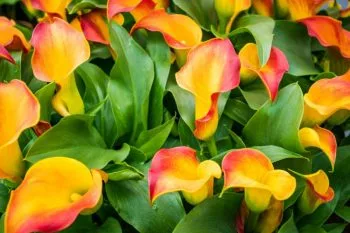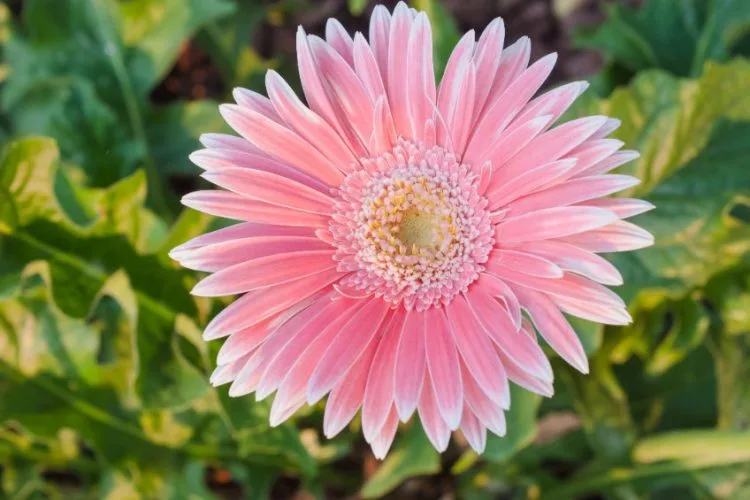Are you looking to add some instant color to your flower beds or entryway? When you incorporate annuals into your landscape, you instantaneously change the look and feel of your home.
Seasonal flowers grow at a faster rate and bloom longer than perennials do. Plus, they are available in a plethora of colors and sizes.
You can put them in the ground or in containers, as well as use them for cut flowers. Imagine having a rainbow of colors inside your home and out.
There are some things you need to know about planting seasonal flowers. This article will discuss those things in detail today.
Get everything done at once by hiring Evergreen Lawn and Landscape for a general clean-up.
Are you looking to add some instant color to your flower beds or entryway? When you incorporate annuals into your landscape, you instantaneously change the look and feel of your home.
Seasonal flowers grow at a faster rate and bloom longer than perennials do. Plus, they are available in a plethora of colors and sizes.
You can put them in the ground or in containers, as well as use them for cut flowers. Imagine having a rainbow of colors inside your home and out.
There are some things you need to know about planting seasonal flowers. This article will discuss those things in detail today.
Get everything done at once by hiring Evergreen Lawn and Landscape for a general clean-up.
Steps for Planting Seasonal Flowers:
- Remove last year’s mulch
- Prepare the soil
- Fertilization
- Weed Control
- Planting
Remove Last Year’s Mulch
The first thing you want to do is to remove the mulch from the previous year. If the mulch was organic and has already broken down, it is fine to till it into the soil.
If you previously used inorganic mulch such as rocks or plastic, you will need to completely remove the mulch in order to prepare the soil.
Leaving old mulch, even organic mulch that hasn’t decomposed can cause rot or death. An excess of mulch will deprive plant roots of nutrients needed to flourish.
Prepare the Soil
The most essential part of planting annuals is to prepare the soil. In layman’s terms, prepping the soil means adding organic matter to the soil.
Perennials have adapted themselves to the soil and climate of the area, which is why it is not necessary to prep the soil when planting them.
RELATED TIP: Why Weed Control is Important
Don C Wilkerson, Ph.D, a professor and Extension Horticulturist from Texas A&M University states, “generally speaking, beds should consist of at least 50% organic matter for best results.” He also discusses the importance of raised beds to ensure plants don’t get flooded when it rains.
Organic matter is made from plant and animal residues. It can be straw, grass clippings, compost, manure, sawdust, etc.
Here in North Texas, many homeowners have clay soil. Clay soil can be improved by adding gypsum. The gypsum will add nutrients to the soil and help to loosen it up. This is another way to prepare the soil.
Test your soil to determine any nutrient deficiencies and to confirm that the soil Ph is within range for optimal growing. Most flowers do well with a Ph in a range of 5.5-6.5.
Next, till the organic matter into the soil about 8-10 inches. The soil should be moist before tilling.
Fertilization
Your seasonal flowers will provide you with glorious pops of color as long as they are well-fed. When properly cared for, many annuals can be planted in spring and will thrive until the first frost.
Put down a granular, time-release fertilizer before you put the flowers in the ground. By using a slow-release fertilizer, your flowers will get food all season long. Thoroughly till the fertilizer into the soil.
If you have more time on your hands, you can choose to go with a water soluble/liquid fertilizer and apply every week. Liquid fertilizers should be applied as needed, depending on plant growth.
If you have completed your soil test beforehand, you will know which nutrients your soil is lacking and this will help you choose the specific type of fertilizer needed.
Weed Control
Put down an herbicide, like Roundup about 3 weeks before planting. Another good idea is to lay down a weed barrier fabric before planting.
RELATED TIP: When to Apply Pre-Emergent for Winter Weeds
Cut holes in the fabric for the plants to fit in and secure fabric with stakes. Use a garden tool to poke smaller tools throughout the fabric for water to get through.
Planting
Check local weather reports to ensure that your area is well past the possibility of a freeze preceding any planting. The soil should be moist when you put the plants in the ground.
Water plants in their containers before putting them in the ground. If the roots are very dense, gently loosen them. You want the root ball to remain intact.
Place plants into holes slightly larger than the root balls. Apply fertilizer to soil after all flowers have been planted.
Put down 2-3 inches of fresh mulch for a polished look. Feeling worn out with all the steps involved with planting seasonal flowers? Evergreen Lawn and Landscape is here to help. We can quickly and efficiently install the mulch for you.
Water well, intermittently. When you water your lawn, you should also be watering your flowers.
Final Thoughts

When you plant seasonal flowers, you are allowing yourself an opportunity to be creative and experiment with different color combinations. If there are any gaps in your flower beds, it’s a perfect place to plant some annuals.
Annuals are inexpensive and come in a wide array of color options. The possibilities of what you can design are endless with annuals.
Evergreen Lawn and Landscape is happy to provide seasonal planting service year-round. Call us today so we can help you add some pops of color into your landscape.
Steps for Planting Seasonal Flowers:
- Remove last year’s mulch
- Prepare the soil
- Fertilization
- Weed Control
- Planting
Remove Last Year’s Mulch
The first thing you want to do is to remove the mulch from the previous year. If the mulch was organic and has already broken down, it is fine to till it into the soil.
If you previously used inorganic mulch such as rocks or plastic, you will need to completely remove the mulch in order to prepare the soil.
Leaving old mulch, even organic mulch that hasn’t decomposed can cause rot or death. An excess of mulch will deprive plant roots of nutrients needed to flourish.
Prepare the Soil
The most essential part of planting annuals is to prepare the soil. In layman’s terms, prepping the soil means adding organic matter to the soil.
Perennials have adapted themselves to the soil and climate of the area, which is why it is not necessary to prep the soil when planting them.
RELATED TIP: Why Weed Control is Important
Don C Wilkerson, Ph.D, a professor and Extension Horticulturist from Texas A&M University states, “generally speaking, beds should consist of at least 50% organic matter for best results.” He also discusses the importance of raised beds to ensure plants don’t get flooded when it rains.
Organic matter is made from plant and animal residues. It can be straw, grass clippings, compost, manure, sawdust, etc.
Here in North Texas, many homeowners have clay soil. Clay soil can be improved by adding gypsum. The gypsum will add nutrients to the soil and help to loosen it up. This is another way to prepare the soil.
Test your soil to determine any nutrient deficiencies and to confirm that the soil Ph is within range for optimal growing. Most flowers do well with a Ph in a range of 5.5-6.5.
Next, till the organic matter into the soil about 8-10 inches. The soil should be moist before tilling.
Fertilization
Your seasonal flowers will provide you with glorious pops of color as long as they are well-fed. When properly cared for, many annuals can be planted in spring and will thrive until the first frost.
Put down a granular, time-release fertilizer before you put the flowers in the ground. By using a slow-release fertilizer, your flowers will get food all season long. Thoroughly till the fertilizer into the soil.
If you have more time on your hands, you can choose to go with a water soluble/liquid fertilizer and apply every week. Liquid fertilizers should be applied as needed, depending on plant growth.
If you have completed your soil test beforehand, you will know which nutrients your soil is lacking and this will help you choose the specific type of fertilizer needed.
Weed Control
Put down an herbicide, like Roundup about 3 weeks before planting. Another good idea is to lay down a weed barrier fabric before planting.
RELATED TIP: When to Apply Pre-Emergent for Winter Weeds
Cut holes in the fabric for the plants to fit in and secure fabric with stakes. Use a garden tool to poke smaller tools throughout the fabric for water to get through.
Planting
Check local weather reports to ensure that your area is well past the possibility of a freeze preceding any planting. The soil should be moist when you put the plants in the ground.
Water plants in their containers before putting them in the ground. If the roots are very dense, gently loosen them. You want the root ball to remain intact.
Place plants into holes slightly larger than the root balls. Apply fertilizer to soil after all flowers have been planted.
Put down 2-3 inches of fresh mulch for a polished look. Feeling worn out with all the steps involved with planting seasonal flowers? Evergreen Lawn and Landscape is here to help. We can quickly and efficiently install the mulch for you.
Water well, intermittently. When you water your lawn, you should also be watering your flowers.
Final Thoughts

When you plant seasonal flowers, you are allowing yourself an opportunity to be creative and experiment with different color combinations. If there are any gaps in your flower beds, it’s a perfect place to plant some annuals.
Annuals are inexpensive and come in a wide array of color options. The possibilities of what you can design are endless with annuals.
Evergreen Lawn and Landscape is happy to provide seasonal planting service year-round. Call us today so we can help you add some pops of color into your landscape.



Comments (0)
Thanks for your comment!
Thanks for your feedback! Your comments have been successfully submitted! Please note, all comments require admin approval prior to display.
Error submitting comment!
There is a problem with your comment, please see below and try again.